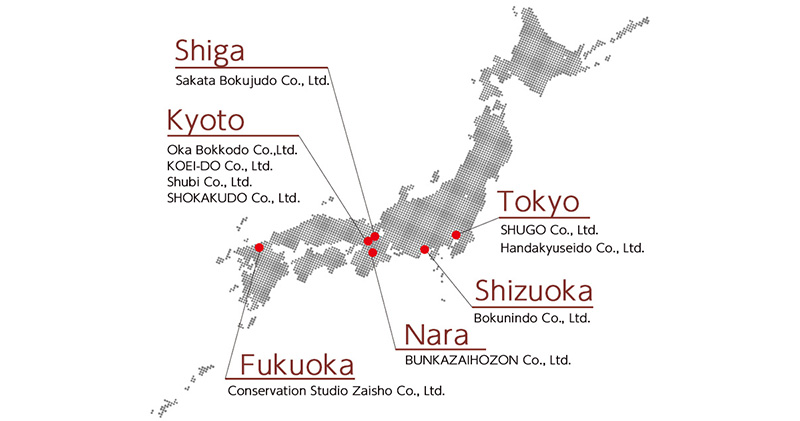Conservator qualification system
In 2003, the ACNT launched a qualification system to certify conservators— both association members and international colleagues—who work with Japanese mounted cultural properties.
This system is open to conservators with excellent skills, ethics, and the right personality for cultural properties conservation. Conservators must participate in requisite seminars, with the caveat that they lose their certification if they lack essential skills. Under this system, conservators are granted one of four levels of qualification — “Assistant Conservator”, “Conservator”, “Chief Conservator”, or “Head Conservator” — based on an objective evaluation of their skills.
“Chief Conservators” must have the knowledge, thinking skills, experience, ethics, descriptive abilities, and other qualities needed to function as front-line conservators. “Head Conservators” are tested for these same qualities and their ability to supervise and lead other conservators. Tests are administered by a committee of members, designated by the ACNT, who have relevant knowledge and experience in the study of conservation science, art history, history, and other fields intimately related to the conservation of cultural properties.
We believe our conservator qualification qualification system sets a demanding standard that is an essential indicator of whether conservators are capable of safely and properly engaging in conservation work. The system is the basis of our seminars and other efforts to develop and train conservators.
ACNT qualification
The general provisions of the conservator qualification qualification system were revised in April 2021.
Standards for certification as a registered conservator
| Head Conservator |
|
|---|---|
| Chief Conservator |
|
| Conservator | Assistant Conservators with at least four years of practical experience (at least two years of practical experience as Assistant Conservators for those who have completed graduate programs), have participated in the Association’s beginner seminars, and whose practical skills have been approved. |
| Assistant Conservator | Individuals who have participated in the Association’s introductory level workshop, and have passed the screening for registration in the conservation technician conservator qualification system. |
Certification examinations
| *Calligraphies I |
People who have the skills and knowledge of all aspects of the conservation of honshi (main artwork) of calligraphies. |
・Conservators who have the knowledge and skills to conserve cultural properties in decorative formats that include fabric and paper mountings for hanging scrolls, handscrolls, booklets, etc. |
|---|---|---|
| *Calligraphies II | ・Conservators who have the knowledge and skills to conserve cultural properties in formats for collections of ancient and historical documents without decorative mountings, including booklet bindings, handscrolls, frames, etc. ・Conservators who have the knowledge and skills to perform leaf casting and conservation with paper-making equipment. |
|
| Paintings I | Conservators who have the skills and knowledge for all aspects of the conservation of East Asian paintings. |
・Conservators who have the knowledge and skills to conserve cultural properties in formats that include fabric and paper mountings for hanging scrolls, handscrolls, folding screens, sliding doors, etc. |
| Paintings II |
・Conservators who have the knowledge and skills to conserve cultural properties in formats that include paintings rendered on walls, panels, and other supports. ・Conservators who have knowledge and skills with pigments including toning, consolidation of painted layers, etc. |
For reference: Defunct certifications
*Conservators who have the skills and knowledge for all aspects of the conservation of East Asian “Calligraphic artworks, Documents and Archives”






